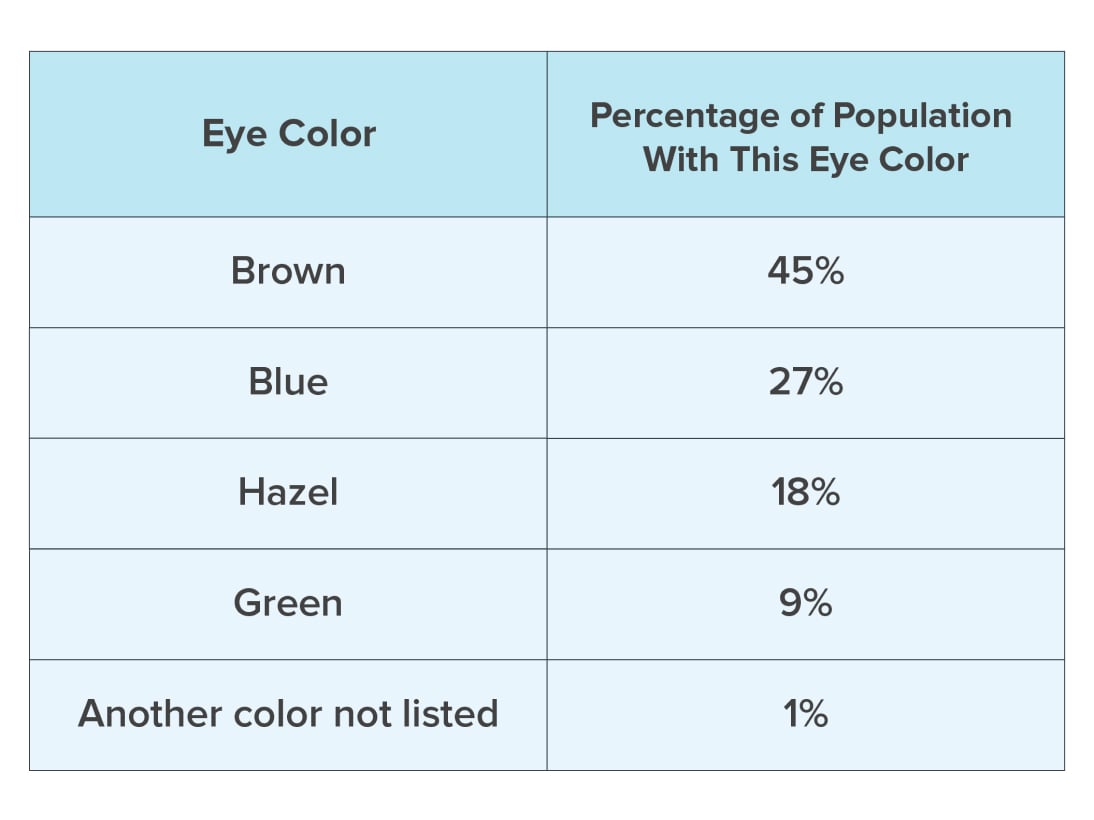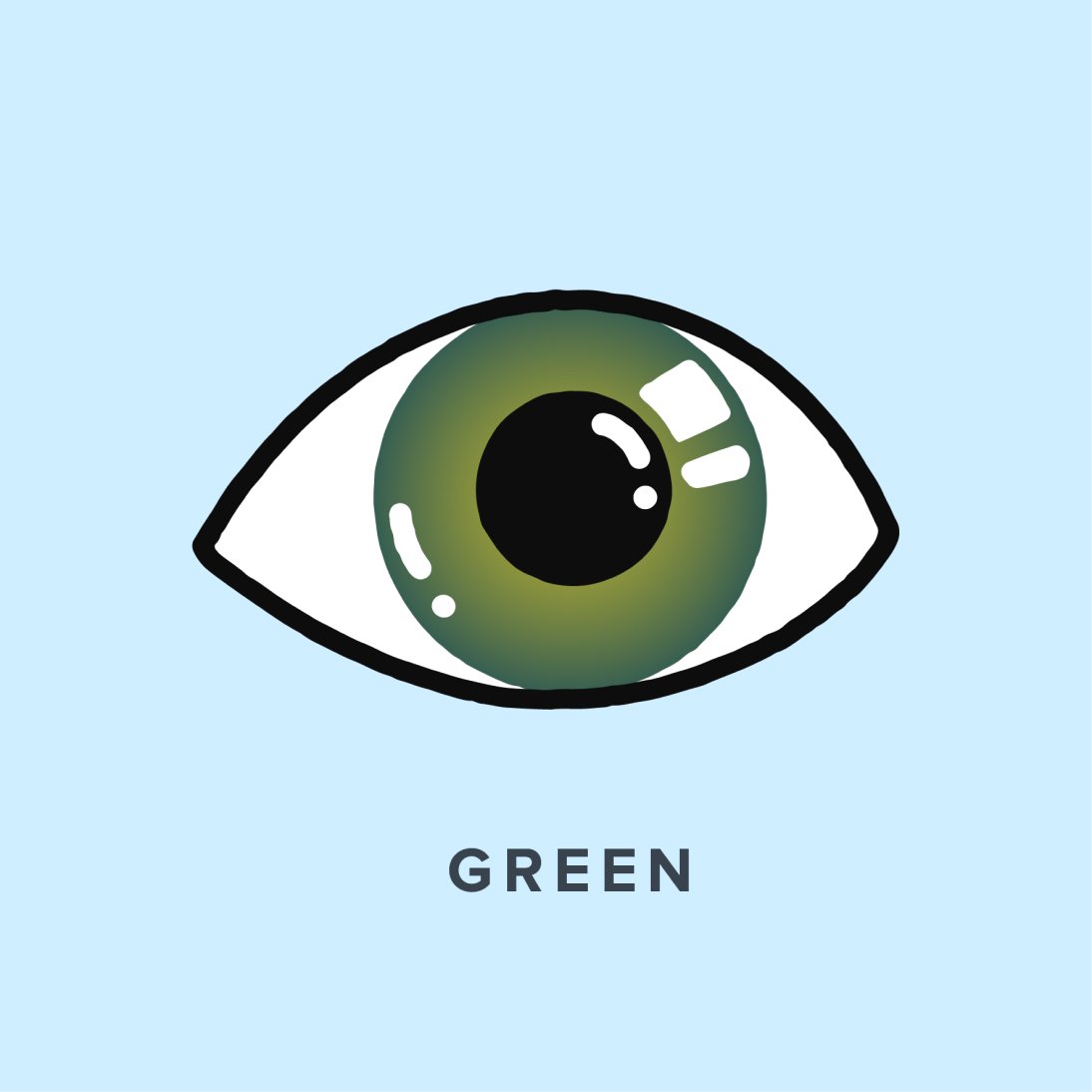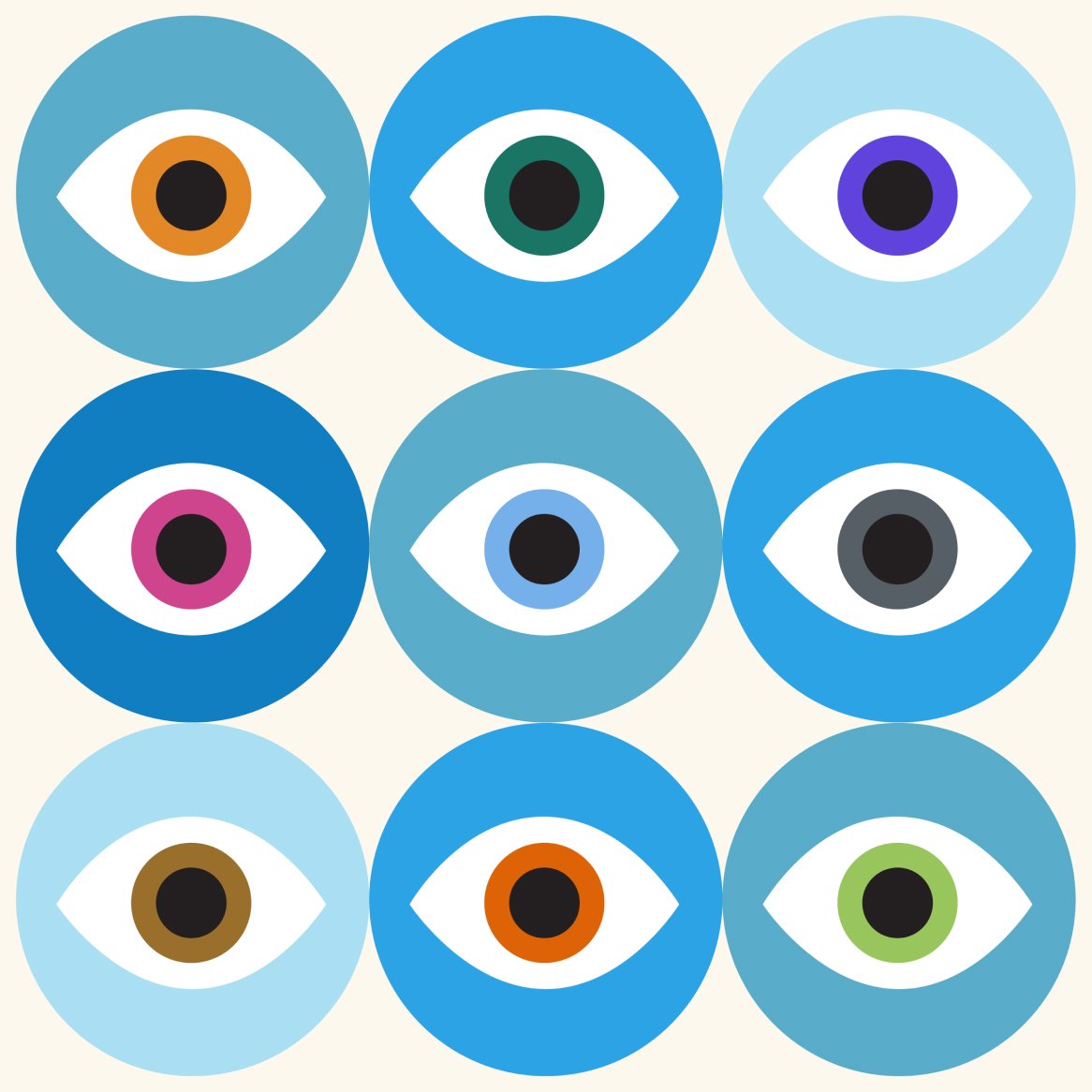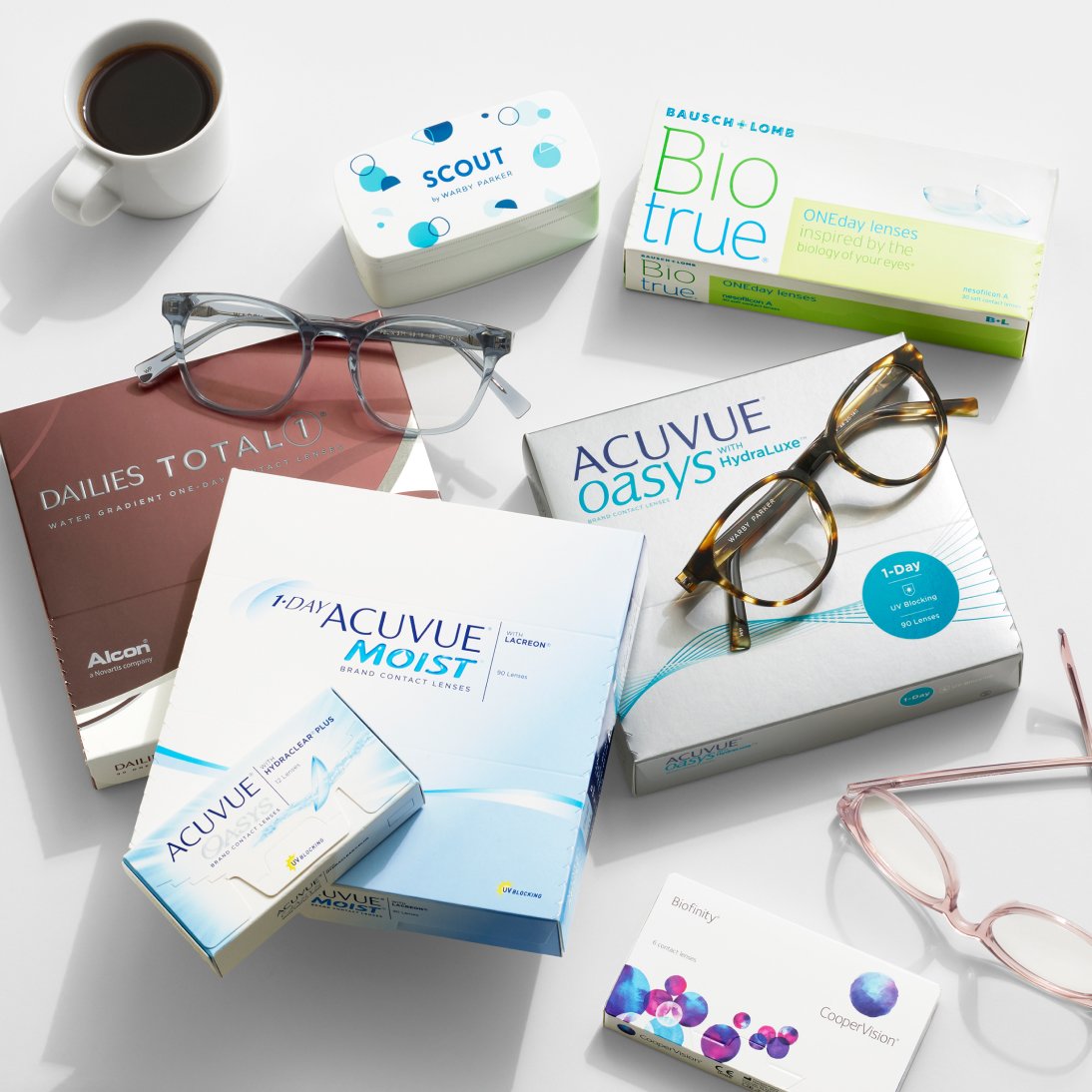What Is the Rarest Eye Color?
The rarest eye color in the world is likely violet or red—and yes, those colors can occur without the help of contacts. Many factors can influence eye color, including genetics and even certain medical conditions.
In this article, we’ll discuss the rarest eye colors, how eye color percentages break down across the population, and how specific health conditions can affect the color of your eyes. But before all that, we’ll look at what determines eye color in the first place.
What Determines Eye Color?
Genetics and melanin are the two key components that help determine a person’s eye color.
Melanin
Differences in eye color (e.g., brown vs. blue) are due to the amount of melanin—a brown pigment—present in the eye.
If you have melanin on both the back and front layers of your iris, that causes your eyes to look brown. On the other hand, eyes with no melanin on the front layer of the iris have a lighter appearance because they have less pigmentation. In other words, more melanin = darker eyes.
Fun fact: You could technically say that almost everyone has brown eyes because even eyes that appear sky blue tend to have brown pigment on the back layer of the iris.
Genes
Has anyone ever told you that you have your mom or dad’s eyes? Well, they’re partially correct! Everyone inherits genes from their parents that influence eye color.
These genes impact the amount and distribution of melanin in your eyes, resulting in a wide variety of possible shades. Research has identified around 16 genes that can influence eye color, though there are two located on chromosome 15 that seem to have the most pronounced effect.
In the past, scientists consulted a much more simplistic model to predict eye color through heredity, but further study has proven that the genetics of eye color are quite complex. This complexity accounts for children who don’t have the same color eyes as either of their parents.
Peep this
Accentuate your unique eye color (and boost your vision) with contacts or glasses.
The Rarest Eye Colors (and Percentages of People Who Have Them)
Brown and blue eyes are two of the most common eye colors in the world, but when it comes to determining the least common eye colors, the numbers aren’t clear-cut. Unfortunately, there haven’t been too many large-scale studies that can accurately tell us the prevalence of different eye colors.
The table below demonstrates how more common eye color percentages break down in the United States, according to a 2014 Harris Poll of 2,000 Americans by the American Academy of Ophthalmology.

But what about the colors not listed here? It’s challenging to find a definitive list of rare natural eye colors because the term “rare” can mean something different depending on the region and the source you’re consulting. (For example, blue eyes wouldn’t be considered rare at all in Iceland!)
When people think of rare eye colors, they may be thinking of any of the following shades:
- Violet
- Red
- Green
- Grey
- Hazel
- Amber
Let’s take a closer look at each of these.
Red or Violet Eyes
Violet and red are unique eye colors caused by an iris with little to no pigment. When light reflects off of the blood vessels in eyes that lack typical pigmentation, the eyes appear violet or red.

Astonishing as it may seem, these eye colors occur naturally—and are extremely rare. But it’s the blood vessels within the eye (not actual red or violet pigment) that are responsible for their appearance. This eye color happens as a result of albinism, a genetic condition that limits or entirely prevents the body’s production of melanin.
According to the National Organization for Albinism and Hypopigmentation, about 1 in 20,000 Americans has albinism, and not every person with albinism has red or violet eyes. It’s a safe bet that less than 1% of the world’s population has this eye color.
Green Eyes
Green is considered by some to be the actual rarest eye color in the world, though others would say it’s been dethroned by red, violet, and grey eyes.

Green eyes don’t possess a lot of melanin, which creates a Rayleigh scattering effect: Light gets reflected and scattered by the eyes instead of absorbed by pigment. This effect makes the eyes look green, but they don’t actually have green pigmentation. That’s right—nobody’s eyes are truly green.
Only around 9% of Americans have green eyes. They’re far more common in certain parts of Europe, and women are more likely to have them than men.
Grey Eyes
Grey eyes represent another eye color rarity. They’re frequently confused for blue eyes at first glance, but unlike blue eyes, grey eyes often have spots of gold and brown in the iris.

Like most light eye colors, the perceived shade of grey-colored eyes comes from a low amount of melanin in the iris and the way that light hits the eye. However, grey eyes also have more collagen in a part of the eye known as the stroma, which can contribute to their grey appearance.
Multiple internet sources say that approximately 3% of the people in the world have grey eyes, but further research is needed to delineate this color from others and examine how widespread it is.
Hazel Eyes
There are many variations of hazel eyes, but they usually sport a yellow-brownish hue with gold, green, and brown specks around the center. If you have hazel eyes, you have as much melanin as someone with brown eyes. However, your melanin is distributed differently—it’s more present around the edge of the iris instead of the center.

Like green eyes, hazel eyes get their color from the Rayleigh scattering effect and a moderate amount of melanin in the iris.
Approximately 18% of Americans have hazel eyes, and research outside of the states is sparse. Some studies don’t reference hazel eyes at all, whereas others refer to this and other greenish eye colors as “intermediate”—that is, any eye color between blue and brown.
Amber Eyes
Amber eyes are sometimes mistaken for hazel eyes, but they carry more melanin and have a more consistent, solid color rather than a blend of shades.
Amber eyes likely contain relatively higher levels of a melanin variant called lipochrome, which carries a golden or orange tint. These eyes almost appear to glow when you look at them.

Amber eyes are uncommon among humans, but animals such as wolves, cats, or owls often have striking amber peepers. Internet sources estimate that about 5% of people have this eye color, but again, true research studies are lacking.
Other Factors That Affect Eye Color
Colored Contacts
If you covet a rare eye color, colored contacts are always an option. These contacts allow you to change your eye color whenever you see fit—maybe sometimes you want hazel eyes, whereas other times violet eyes speak to you. There are numerous color options out there, so you’ll likely be able to find the hue of your dreams.
Colored contact lenses are available in a wide range of vision-correcting prescriptions. Even if your eyesight is perfect, you should only wear contacts that are prescribed to you by your eye doctor.
Health Conditions and Injuries
A few eye conditions that can affect the color of someone’s eyes include the following:
- Albinism: Albinism is a condition that affects the amount of melanin a person produces in their skin, hair, and eyes. A person with albinism may have light blue, violet, pink, or red eyes.
- Heterochromia: Heterochromia is a condition that causes each eye to be a different color. For example, a person with heterochromia may have one brown eye and one blue eye.
- Anisocoria: Anisocoria is a form of heterochromia that causes a person to have unequal pupil sizes (one of their pupils is larger than the other). This condition can make one eye look darker than its partner.
- Arcus senilis: Arcus senilis is a common condition that correlates with aging and high cholesterol levels. It results in a grey, blue, or white ring of lipid deposits around the cornea.
- Cataracts: Cataracts occur when an eye’s natural lens becomes cloudy, which often causes blurred vision. Eyes with cataracts may appear white or grey.
- Hyphema: Hyphema happens when blood collects inside the front of the eye. The blood may cover part or all of the iris and the pupil, making part of the eye look red. Sports injuries are a common cause of hyphema.
- Uveitis: Uveitis is another word for inflammation inside a person’s eye, which can be caused by infection, injury, or toxins. The white part of the affected eye may look red.
Mood
Can a person’s mood cause their eyes to change color? Unfortunately, this is more myth than reality. When your mood shifts from one emotion to another, your pupils may dilate or constrict. This change in pupil size can cause your eyes to appear slightly lighter or darker, but there’s no actual change in pigmentation.
Your Eye Color Is as Complex as You Are
To recap: Eye colors come in many shades. They can range from light to dark, and from blue to almost black, with distinct spots of colors blended into the iris. Your eye color comes from your genetic makeup and, more specifically, the amount of melanin your body makes. The more melanin you have, the darker your eyes are likely to be.
What eye color is the rarest? Eyes with irises that lack pigmentation and appear to be red or violet seem to top the list. But more research is needed to identify the rarest natural eye colors and their prevalence in the world population. As for us, we think all eyes are beautiful and unique, no matter their hue. And of course, the right pair of glasses can really make your eye color pop.
We’ve got your eyes covered
Shop eyeglasses, sunglasses, contacts, and accessories all in one place—plus enjoy free shipping and returns.
Shop now












